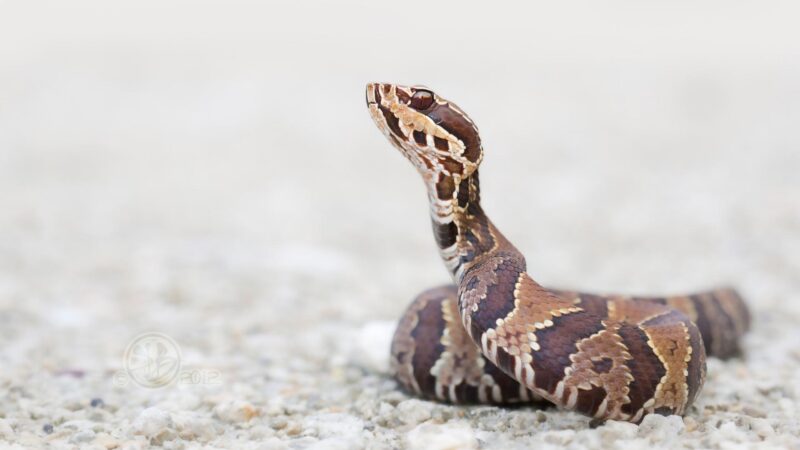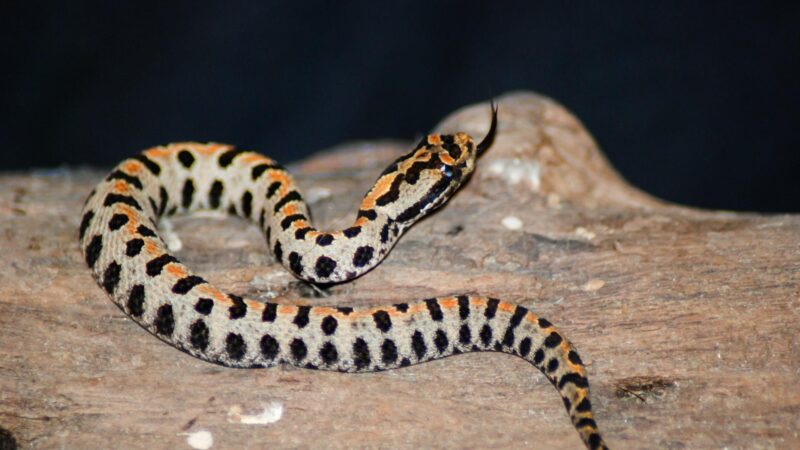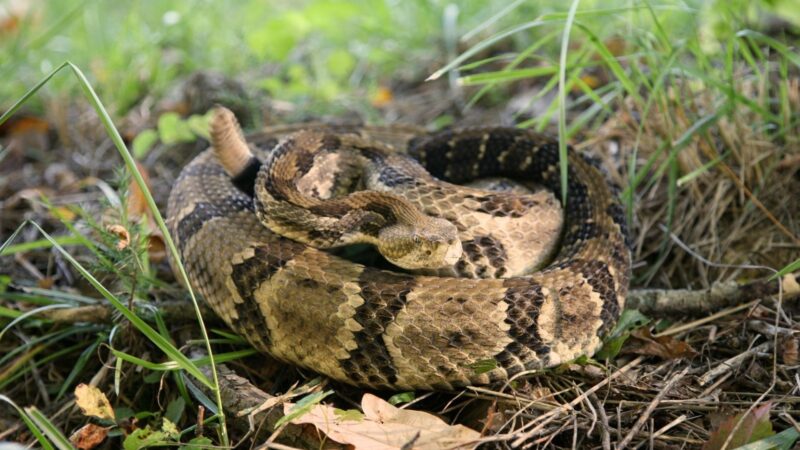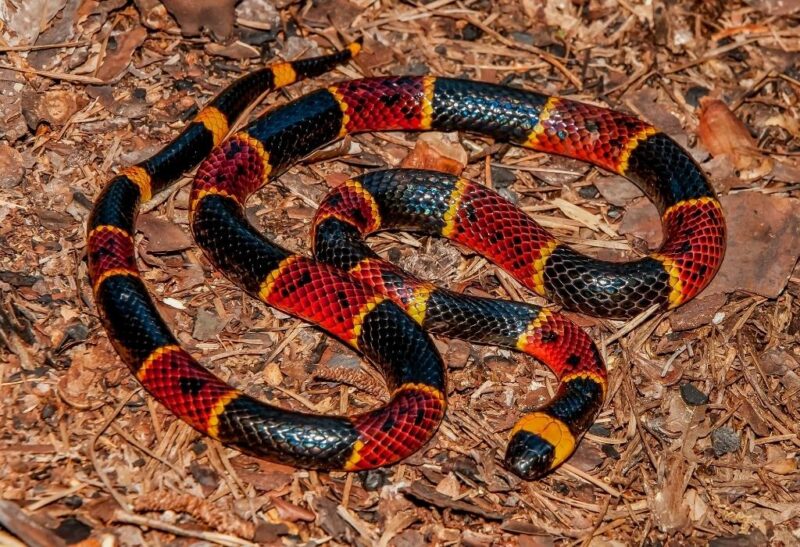Georgia is one of the most beautiful states in the country, with its picturesque beaches and panoramic mountains. It’s also teeming with wildlife – including around 46 recorded snake breeds within its borders. Curiously, are all of these snakes venomous or not? This article will give you the answer.
So, are there any venomous snakes in Georgia? Out of the 46 known snake breeds in the state, six of them are considered venomous. The six venomous snakes in Georgia are:
- Southern Copperhead
- Cottonmouth
- Eastern Coral Snake
- Pigmy Rattlesnake
- Timber Rattlesnake
- Eastern Diamondback Rattlesnake
If you want to learn more about each of these venomous snakes, you came to the right place. You’ll also learn some facts about snakes that will help you repel them from coming close to your home.
Table of Contents
Are There Any Venomous Snakes in Georgia?
There are venomous snakes in Georgia. Georgia is known for being home to a wide variety of snake species – a total of 46 recorded as of date. In fact, the state is recognized for having the largest snake diversity in the country. Fortunately, only six out of the 46 snakes are considered venomous.
6 Venomous Snakes in Georgia
Southern Copperhead

Out of the six venomous snakes in Georgia, the Southern copperhead is the most prevalent in the state. It is often found in the state’s northern mountains or forested areas but has sometimes made its way to some suburban areas.
While the Southern copperhead only has small fangs, it is considered a highly venomous snake species. Fortunately, its venom is not considered fatal, but it can trigger quite an allergic reaction, especially among the immunocompromised group of people, including the elderly.
- Scientific Name: Agkistrodon contortrix contortrix
- Appearance: As its name implies, the Southern copperhead snake has a small rounded head that’s covered in copper or reddish-brown scales. Meanwhile, the rest of its body is covered in pale brown, light tan, or pinkish-brown scales. The length of its body is covered in hourglass-like patterns. They also have distinct yellow eyes with pupils shaped like that of a cat’s.
- Color: Pale brown, light tan, and pinkish
- Lifespan: 18 years
- Length: 2 to 4 feet
- Diet: Rabbits, rats, mice, birds, snakes, lizards, turtles, frogs, toads, and insects, as well as baby cottontail snakes
- Place Of Origin: Southern and the Eastern United States
Cottonmouth

Another venomous snake in Georgia is the cottonmouth. These snakes are semi-aquatic and are often found foraging in freshwater areas for food, such as fish and water birds.
Otherwise known as a water moccasin, the cottonmouth snake is known for its toxic venom that could easily trigger severe allergic reactions. However, this snake species is known for its non-aggressive nature – only attacking when provoked or threatened.
- Scientific Name: Agkistrodon piscivorus
- Appearance: Cottonmouth snakes have dark-colored scales covering their medium-length body. This snake species derives its name from the cotton-white color on the insides of its mouth. They have a large triangular-shaped head and elliptical eyes. They also have a pattern of dark-colored lines running across its body.
- Color: Brown to black
- Lifespan: 10 years
- Length: 2 to 4 feet
- Diet: Frogs, fish, and water birds, as well as small snakes, including baby cottonmouths
- Place Of Origin: Southeast to the Midwest United States
Eastern Coral Snake

The Eastern coral snake is among the most beautifully-colored snakes out there. It has bright-colored scales that make it hard to miss. However, don’t let their unassuming appearance fool you – these snakes are quite venomous.
Eastern coral snakes may have short fangs, but their venom is quite potent. White its bite doesn’t usually cause skin swelling or pain, it should be treated immediately. Eastern coral snake venom that’s left untreated can cause muscle paralysis or even cardiac arrest in extreme instances.
- Scientific Name: Micrurus fulvius
- Appearance: Eastern coral snakes have small bulb-like heads coupled with long, slender bodies. Also, these snakes are best known for the bright red, black, and yellow bands all over its body.
- Color: Red, yellow, and black
- Lifespan: 7 years
- Length: 2 feet
- Diet: Lizards, frogs, and smaller snakes, including other coral snakes
- Place Of Origin: Southern United States, Argentina
Pigmy Rattlesnake

The pigmy rattlesnake may be among the smaller rattlesnake species, but don’t let its size fool you. They’re incredibly fast and agile, which comes to an advantage when they’re out hunting.
While its venom is not lethal, it is still known for excruciatingly painful bites and moderate allergic reactions. It is still advised to seek medical attention as soon as you get bit by this rattlesnake.
- Scientific Name: Sistrurus miliarius
- Appearance: Pigmy rattlesnakes have short yet thick bodies characterized by a pattern of dorsal spots across their body. Some pigmy rattlesnake subspecies have dark-colored scales, while others have light gray with pale orange stripes.
- Color: Light to dark gray
- Lifespan: 20 years
- Length: 1 to 2 feet
- Diet: Birds, lizards, frogs, and insects
- Place Of Origin: Southeastern Georgia
Timber Rattlesnake

Another venomous rattlesnake in Georgia is the timber rattlesnake. Otherwise known as the American viper, this large snake breed is infamous for its venom that causes swollen bite sites. The swollen skin also turns dark instead of the usual pinks or reds. Fortunately, it can be treated with prompt medical intervention.
What you have to bear in mind about the timber rattlesnake is that it doesn’t attack for no reason. Like most snakes, it only bites when it feels threatened or provoked.
- Scientific Name: Crotalus horridus
- Appearance: Timber rattlesnakes have long and large bodies with hourglass-shaped patterns across the length of their body. Some of its subspecies come in gold and black colors, while others come in brown and pale pink colors.
- Color: Dark brownish gold with shades of black
- Lifespan: 30 years
- Length: 2.5 to 6 feet
- Diet: Rodents, birds, lizards, and amphibians
- Place Of Origin: Eastern United States
Eastern Diamondback Rattlesnake
It comes as no surprise that the largest rattlesnake in North America, the Eastern diamondback rattlesnake, is found in Georgia. And aside from being the largest, it is also one of the most venomous. A single bite can inject large quantities of venom that could potentially lead to death if left untreated.
- Scientific Name: Crotalus adamanteus
- Appearance: This snake species has a distinct diamond-like pattern all over its back – hence the name. It also has a long, thick body that narrows down as it reaches the tip where the rattle is.
- Color: Blackish-gray, olive green, and muddy gray
- Lifespan: 15 to 20 years
- Length: Up to 8 feet
- Diet: Small mammals, including fellow snakes like cottontail snakes
- Place Of Origin: Southeastern United States
Can You Kill Copperheads in Georgia?
You can kill copperheads in Georgia. According to Georgia State Law, specifically OCGA 27-1-28, it is illegal to hunt, trap, possess, or transport non-game species of wildlife, which includes its non-venomous snake species. Failure to observe said law entitles the accused to a year in jail and a fine of $1000.00.
But, the same law excludes poisonous or venomous snakes from its protection. Since copperheads are among the six venomous snake species in Georgia, then it’s safe to say that you can kill copperheads.
Can You Kill a Rattlesnake in Georgia?
It depends. As earlier established, it is legal to kill venomous snakes in Georgia. However, it must be noted that not all rattlesnakes are considered venomous.
Among the venomous rattlesnakes in Georgia are the Eastern Diamondback Rattlesnake, Timber Rattlesnake, and Pigmy Rattlesnake. Thus, make sure that the snake you’re dealing with is one of these three. Otherwise, you might end up facing charges and some jail time.
Frequently Asked Questions
What Smell Do Snakes Hate?
Snakes have a strong sense of smell, which they take advantage of in hunting their prey. However, that also means they can be easily repelled by a smell they don’t like. According to a study, the smells that snakes find repulsive are cinnamon oil and clove oil. It has also been observed that snakes hate the smell of onion and garlic.
What Chemical Kills Snakes Instantly?
Calcium cyanide is a chemical that’s known for killing snakes almost instantly. It is often used against venomous rattlesnakes that prefer to hide under burrows dug by other animals.
Does Irish Spring Keep Snakes Away?
It has been observed that Irish Spring can keep snakes away. Irish Spring has quite a strong scent, and it seems that snakes find it repugnant.
What Plant Keeps Snakes Away?
Plants like marigolds, onion, and garlic are known to keep snakes away. The marigold plant’s roots emit a strong spicy scent that drives snakes away. Interestingly, these roots often go deep underground, so burrowing snakes are also repelled by them.
As for garlic and onion, these plants emit a strong scent due to their sulfenic acid content. This strong scent also seems to drive snakes away.
Do Moth Balls Keep Snakes Away?
Experts reveal that moth balls have little to no effect in driving away snakes. However, moth balls are effective against other house pests which are considered prey for snakes.
To conclude, Georgia is home to a diverse variety of snake species, including six that are venomous. These are the southern copperhead, the cottonmouth, the eastern coral snake, the pigmy rattlesnake, the timber rattlesnake, and the eastern diamondback rattlesnake. But if you ever encounter one, make sure to stay calm. More often than not, they only show aggression if they feel threatened.
List of Sources
Hoppers, A. (2020). Georgia’s Snakes. University of Georgia.
Snake Repellents. (2003). United States Department of Agriculture Animal and Plant Health Inspection Service.
Hessel, M. H., McAninch, S. A. (2022). Coral Snake Toxicity. StatPearls Publishing.
Andrews, K. Cottonmouth / Water Moccasin (Agkistrodon piscivorus) – Venomous. Savannah River Ecology Laboratory.
